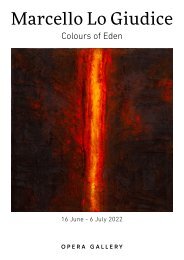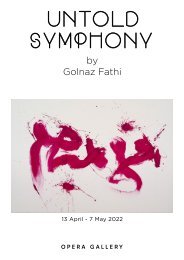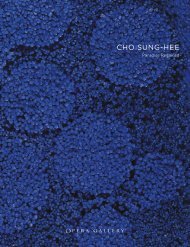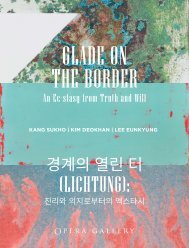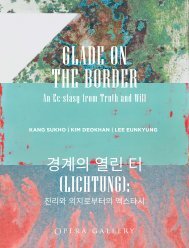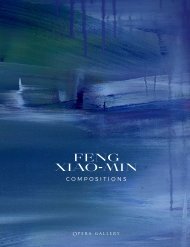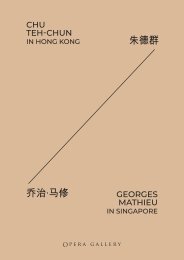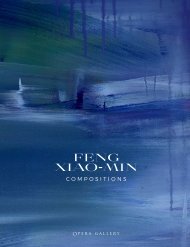Brilliant Hues: The Power of Red & Gold
You also want an ePaper? Increase the reach of your titles
YUMPU automatically turns print PDFs into web optimized ePapers that Google loves.
i l l i a n t h u e s<br />
the power <strong>of</strong> red & gold
9 - 25 February 2018<br />
b r i l l i a n t h u e s<br />
the power <strong>of</strong> red & gold
Preface<br />
<strong>The</strong> creative application <strong>of</strong> gold has existed since ancient times. It has been<br />
used ubiquitously across cultures inter-continentally from the North African’s<br />
<strong>of</strong> Egypt, the intricate adornment <strong>of</strong> the Middle East, the Aztecs, Mayans and<br />
Incas <strong>of</strong> the Americas, the Christian artisans <strong>of</strong> Europe and in the sacred artists<br />
<strong>of</strong> the East from Russia to China and all in between. It’s use has always been<br />
multi-faceted, reflecting power and wealth alongside divinity, communicating<br />
spiritual truth and illumination across cultures.<br />
<strong>The</strong> use <strong>of</strong> the colour red dates back to the dawn <strong>of</strong> human expression. <strong>Red</strong><br />
ochre pigment was used in the very first prehistoric cave paintings. <strong>Red</strong> <strong>of</strong>ten<br />
symbolises life itself and its fragility. Emotionally, it represents our richest<br />
human passions and intensity <strong>of</strong> feeling, love and hate and abundance<br />
<strong>of</strong> energy. In Chinese culture for example, it is a colour <strong>of</strong> celebration,<br />
recognised as a sign <strong>of</strong> vitality, joy and good fortune. Its use is diverse but<br />
always rich.<br />
Opera Gallery Singapore presents <strong>Brilliant</strong> <strong>Hues</strong>: <strong>The</strong> <strong>Power</strong> <strong>of</strong> <strong>Red</strong> and <strong>Gold</strong>,<br />
a curated selection <strong>of</strong> artworks which celebrate these two primal pigments<br />
at the heart and pinnacle <strong>of</strong> our unified expression <strong>of</strong> truth, zeal, hope and<br />
prosperity. What could be more innate and intrinsic as red pulses through<br />
our bodies colouring us, warmed by the golden sun that shines above us,<br />
sustaining life for our entire planet?<br />
Gilles Dyan | Founder and Chairman <strong>of</strong> Opera Gallery Group<br />
Stéphane Le Pelletier | Director <strong>of</strong> Opera Gallery Singapore<br />
3
Kossi Aguessy (1977-2017)<br />
Kossi Aguessy was born in Lomé, Togo, in 1977. He studied Industrial and Interior design at<br />
Central Saint Martins in London, England. In 2008, Aguessy gained international prominence<br />
with his ‘Useless Tool’, a chair manufactured using military aircraft technology. <strong>The</strong> following<br />
year, Aguessy’s ‘Sparkling Joke’ c<strong>of</strong>fee table, made from recycled plastic bottles and caps,<br />
caught the attention <strong>of</strong> the Coca-Cola Company. Aguessy subsequently collaborated with the<br />
brand to produce a set <strong>of</strong> furniture made entirely from recycled materials and was commissioned<br />
to design ‘Césarion’, the <strong>of</strong>ficial trophy given to the winners <strong>of</strong> the Coca-Cola Sustainable Design<br />
Award. Aguessy’s research into new technologies and sustainable energy motivated him to<br />
participate in the creation <strong>of</strong> Benin’s first Fab Lab (Fabrication Laboratory), partly funded by the<br />
Centre Pompidou in Paris, France. His works have also entered the permanent collection <strong>of</strong> the<br />
museum, and he became the first designer <strong>of</strong> African descent to be granted a nominative section<br />
in this prestigious institution.<br />
I-Doll, <strong>The</strong> Earth, 2016<br />
Mirror polished bronze, edition <strong>of</strong> 8 . 55 x 30 cm | 21.7 x 11.8 in<br />
4
5
Yasmina Alaoui (b. 1977) and Marco Guerra (b. 1965)<br />
Yasmina Alaoui began collaborating with Chilean photographer Marco Guerra in 2005. Alaoui<br />
paints intricate, henna-inspired patterns onto Guerra’s statuesque and sensual black and white<br />
nude photographs, revealing an intricate combination <strong>of</strong> painting and portraiture. <strong>The</strong> resultant<br />
fusions are both mysterious, sensual and carnal. <strong>The</strong>ir work has been exhibited worldwide and<br />
forms part <strong>of</strong> the collections <strong>of</strong> the Marrakech Museum <strong>of</strong> Photography, the Brooklyn Museum in<br />
New York, the Art Museum <strong>of</strong> Sana'a in Yemen and the Quai Branly Museum in Paris.<br />
<strong>Red</strong> 2, 2011<br />
C-Print, diasec, dibound and aluminium braces, edition <strong>of</strong> 5 . 127 x 84 cm | 50 x 33 in<br />
6
7
Paul Alexis (b. 1947)<br />
Paul Alexis was born in France in 1947. Alexis has spent the majority <strong>of</strong> his life travelling in<br />
search <strong>of</strong> spiritual harmony and creative development. Alexis’ art is infused with an abstracted<br />
realism that forces the viewer into a double take. Lurking within the layers is a familiar image,<br />
<strong>of</strong>ten obscured up close, but as the viewer steps back a face, an object or an icon is revealed<br />
from the painterly shadows. Preferring to work in large formats, Alexis’ works engulf the viewer<br />
with purity <strong>of</strong> colour and veiled forms. <strong>The</strong> joy <strong>of</strong> recognition becomes an integral part <strong>of</strong> the<br />
viewer’s experience.<br />
Laetitia Casta, 2011<br />
Oil on canvas . 81 x 100 cm | 32 x 39.5 in<br />
8
9
Thierry Bisch (b. 1953)<br />
Thierry Bisch was born in Strasbourg, France in 1953. Bisch moved to Paris in 1984. He<br />
achieved success as the co-founder <strong>of</strong> the record label ‘Reflexes’, and later helped to create<br />
and develop graphics and comic strips for a well known French magazine. Since 2008, Bisch has<br />
worked with the International Union for Conservation <strong>of</strong> Nature (IUCN) <strong>Red</strong> List <strong>of</strong> Threatened<br />
Species. He directed the project ‘Les murs de l’Arche’ (the Ark’s Walls), which involved painting<br />
large-scale murals <strong>of</strong> the endangered animals on buildings and walls in city centres. Bisch’s<br />
works have been exhibited in London, Monaco, Dubai, Hong Kong, Seoul, Malaysia, Singapore<br />
and across the United States, France and Spain.<br />
<strong>Red</strong>bull 20, 2007<br />
Mixed media on canvas . 170 x 150 cm |<br />
67 x 59 in<br />
10
11
Bernard Buffet (1928-1999)<br />
Bernard Buffet was born in Paris in 1928 where he lived until his death in 1999. He was a<br />
well-known painter <strong>of</strong> Expressionism and member <strong>of</strong> the anti-abstract art group ‘L'homme<br />
témoin’ (<strong>The</strong> Witness Man). At just fifteen years <strong>of</strong> age, Buffet commenced his studies at the<br />
Paris École des Beaux-Arts. He was a young man during World War II, the pr<strong>of</strong>undity <strong>of</strong> which<br />
greatly affected his childhood and stayed with him throughout his life. His restricted palette,<br />
the melancholy nature <strong>of</strong> his protagonists and his unique sketched style with its black, angular<br />
strokes, are the visible characteristics which embody the dark and light <strong>of</strong> the human condition.<br />
Embodying Jean-Paul Sartre’s Existentialism and Albert Camus’ Absurdism, Bernard Buffet’s<br />
painting conveyed the anxiety that permeated France during the Occupation and came to<br />
dominate the post-war figurative art scene. Buffet’s oeuvre was loved by the public but fell out<br />
<strong>of</strong> favour with the art establishment in the 1960's. Buffet created 8,000 pieces <strong>of</strong> art during his<br />
lifetime and his distinct style and inarguable influence has since inspired posthumous critical<br />
acclaim. In 1973, the Bernard Buffet Museum was inaugurated in Japan. Ever since, the artist’s<br />
work has been featured in the most prestigious modern art collections around the world including<br />
the MoMA, New York, the Musée d’Art Moderne, Paris and the State Tretyakov Gallery in Moscow.<br />
Bouquet de fleurs au vase, 1959<br />
Gouache, watercolour and ink on paper . 65 x 50 cm | 25.6 x 19.7 in<br />
12
13
Mauro Corda (b.1960)<br />
Born in 1960 in Lourdes, France, Mauro Corda displayed a talent for sculpting at a very early<br />
age. At fifteen, he was admitted to the École des Beaux-Arts <strong>of</strong> Reims and later went on to<br />
finish his studies in Paris. Predominantly a sculptor <strong>of</strong> the figure, Corda uses a rich variety <strong>of</strong><br />
materials such as bronze, aluminium, iron, stainless and polished steel as well as glass for<br />
his forms. Corda’s work has been exhibited in a number <strong>of</strong> international museums including<br />
the Museo Eduardo Sívori in Buenos Aires, Argentina, the Museo Victor Hugo in Cuba and the<br />
Museo Frederic Marès <strong>of</strong> Barcelona, Spain, and has been exhibited extensively in art galleries<br />
internationally. He has been the recipient <strong>of</strong> several awards, including the Paul Belmondo Award<br />
and the French Order <strong>of</strong> Arts and Letters.<br />
Collection Automne, 2007<br />
Gilded bronze, edition <strong>of</strong> 8 . 84 x 50 x 35 cm I 33 x 19.7 x 13.8 in<br />
14
15
Cho Sung-Hee (b.1949)<br />
Cho Sung-Hee was born in Korea in 1949. She has studied in the United States and in France and<br />
currently lives and works in Seoul, Korea. Cho is a visionary artist, who makes images through the<br />
use <strong>of</strong> ‘hanji’, a traditional Korean paper. Often Cho’s works appear as a monochrome surface,<br />
such as bright red, s<strong>of</strong>t grey or pure white. In constructing the surface <strong>of</strong> her works, the artist<br />
uses a collage method in which many circles are hand-cut or gently torn, then layered with oil<br />
pigments and placed one atop another. Cho successfully combines a traditional Korean sensibility<br />
with her unique vision and personal narrative. Her works explore the complex relationship between<br />
colour and texture through a labour intensive, time-consuming process. Her works explore a search<br />
for a national identity, reminiscent <strong>of</strong> the Monochrome Art Movement, from the late 1960s to the<br />
1980's, recalling artists like Park Seo-Bo (b.1931) and Keon Young Woo (b.1926). <strong>The</strong> Monochrome<br />
Movement was a generation <strong>of</strong> artists who combined Asian philosophies with Western training.<br />
Cho's works have been exhibited and collected in various prestigious private and public institutions<br />
including the Museum <strong>of</strong> Contemporary Art in Seoul, the Sejong Art Centre in Seoul, the Telentine<br />
Art Centre in Chicago, the L.A. Korea Cultural Service in Los Angeles, the New York Cultural Service<br />
in New York, the Mutual Saving and Finance Company in Seoul and Domino Foods Inc in New York.<br />
<strong>The</strong> Star in the Cosmos, 2012<br />
Mixed media . 227 x 182 cm | 89.4 x 71.7 in<br />
16
17
Feng Xiao-Min (b. 1959)<br />
Feng Xiao-Min was born in Shanghai, China, in 1959. Feng's passion for art was clear from<br />
a very young age. After fine arts studies in China, he moved to France in 1988 and enrolled<br />
at the Ecole nationale supérieure des beaux-arts in Paris. Feng was later invited to teach<br />
at the same prestigious institution. His artworks show a mastery <strong>of</strong> colour and capacity for<br />
manipulating brushstrokes with a graceful and powerful, poetic spirit, akin to the works <strong>of</strong> Chinese<br />
masters Zao Wou-ki and Chu Teh-Chun, with whom he worked closely to perfect his art form.<br />
Feng has also published a number <strong>of</strong> books on painting and calligraphy and many <strong>of</strong> his works<br />
now illustrate the pages <strong>of</strong> French school manuals. His works are collected and presented<br />
in various private and public collections, including galleries, museums and foundations, in<br />
France and abroad. Feng frequently exhibits at international art fairs and biennales and was<br />
commissioned to produce work for the 2017 BRICS summit.<br />
Composition n°2-3-09, 2009<br />
Acrylic on paper laid on canvas . 105 x 95 cm | 41.3 x 37.4 in<br />
18
19
Katrin Fridriks (b.1974)<br />
Born in 1974 in Reykjavik, Iceland, Katrin Fridriks is a conceptual abstract painter, living and<br />
working in Luxembourg. She fuses the natural energies <strong>of</strong> her native Iceland with an explosive,<br />
organic, abstract expressionism along with subtle Japanese calligraphic elements. Often<br />
presented through installations & visual compositions, she has given an architectural dimension<br />
to her paintings. Through a wide range <strong>of</strong> works, Fridriks communicates her questioning <strong>of</strong> the<br />
world, human existence and potential futures. An endless development <strong>of</strong> material and technique<br />
sees many <strong>of</strong> her pieces constantly reworked and evolving. Through creating new perspectives,<br />
Fridriks’ work brings an innovative dimension to her form <strong>of</strong> abstraction.<br />
<strong>Gold</strong>en Wave Awareness, 2016<br />
Acrylic on canvas . 100 x 100 cm | 39.4 x 39.4 in<br />
20
21
Alfred Haberpointner (b.1966)<br />
Born in 1966 in Ebenau, Austria, Alfred Haberpointner studied at the School <strong>of</strong> Sculpture in<br />
Hallein and at the University <strong>of</strong> Design in Linz with pr<strong>of</strong>essor Erwin Reiter. He now lives and works<br />
in Leonding, Austria. He works using wood as his primary medium harnessing all its nuances<br />
and shades. His works are on the one hand figuratively recognisable and comprehensible, and<br />
on the other hand remain arrested in their abstract geometry. Whether he shrouds his wooden<br />
heads with lead or pierces them with pins, the underlying wood form always remains visible. In<br />
1990 Haberpointner received the Award <strong>of</strong> the Academy <strong>of</strong> Art and Industrial Design in Linz,<br />
Austria and in 1997 he received the <strong>The</strong>odor Körner Prize for the Promotion <strong>of</strong> Science and Art.<br />
W-RRYZ, 2015<br />
Stained sprucewood . 200 x 151 x 20 cm | 78.7 x 59.4 x 7.9 in<br />
22
23
W-NNOX, 2015<br />
Stained sprucewood . 61 x 60 cm | 24 x 23.6 in<br />
24
25
Ran Hwang (b. 1960)<br />
Ran Hwang is a Korean installation artist who studied at the School <strong>of</strong> Visual Arts in New<br />
York, USA, and attended the Graduate School <strong>of</strong> Fine Arts at Chung-Ang University in Seoul,<br />
Korea. She is best known for her mesmerising, large-scale wall installations constructed from<br />
thousands <strong>of</strong> meticulously placed buttons, beads, pins and threads on wooden panels. Hwang<br />
hammers thousands <strong>of</strong> industrially produced elements into a support with an almost Zen-like<br />
meditative process. Hwang’s works suggest, metaphorically and paradoxically, the resilience<br />
and persistence <strong>of</strong> nature in the face <strong>of</strong> mass commercial production. Ran Hwang has held<br />
exhibitions notably in the USA at the International Museum <strong>of</strong> Art & Science in McAllen, Texas,<br />
as its first artist-in-residence, as well as at MASS MoCA in Massachusetts, the Queens Museum<br />
<strong>of</strong> Art in New York, the Hudson Valley Centre for the Arts in New York, the Chelsea Art Museum in<br />
New York and the Seoul Arts Centre in Korea. Her work is included in the permanent collections<br />
<strong>of</strong> the Brooklyn Museum, the Hammond Museum, the Hermès Singapore Collection and the Des<br />
Moines Art Centre in Iowa.<br />
Healing Blossoms RG, 2016<br />
Paper buttons, beads, pins on plexiglas . Diameter 109 cm | 43 in<br />
26
27
Healing Blossoms AR1, 2017<br />
Paper buttons, beads, pins on plexiglas . 170 x 236 cm | 66.9 x 92.9 in<br />
28
29
Peter Klasen (b. 1935)<br />
Peter Klasen was born in Lübeck, Germany in 1935, into a family <strong>of</strong> artists and collectors.<br />
He later studied at the Berlin University <strong>of</strong> the Arts. Klasen has lived and worked in Paris since<br />
the 1960’s. He was a founding member <strong>of</strong> the Figuration Narrative movement which included<br />
fellow artists Erró, Valerio Adami, Antonio Seguí and Hervé Télémaque. Klasen experiments with<br />
a wide range <strong>of</strong> materials and techniques, from neon light to collage with found objects. He<br />
<strong>of</strong>ten produces large-scale works that are influenced by an eclectic range <strong>of</strong> imagery, with the<br />
common purpose <strong>of</strong> reflecting the contemporary experience. Klasen has exhibited extensively in<br />
museums and galleries in France, Asia and the Americas.<br />
Love, 2008<br />
Mixed media . 94 x 120 cm | 37 x 47.2 in<br />
30
31
Yves Klein (1928-1962)<br />
Born in 1928, Yves Klein was one <strong>of</strong> the most important artists in post-war European art and<br />
a key figure in the French artistic movement Nouveau Réalisme, which was founded in 1960<br />
by the art critic Pierre Restany. Klein is known above all for his blue monochrome paintings,<br />
which were rendered in International Klein Blue, a bright blue pigment that was to become the<br />
artist’s trademark. Influenced by Zen and other metaphysical philosophies, Klein believed his<br />
blue paintings opened onto an immaterial and infinite space that was akin to a pure idea. As<br />
the artist once famously said, "Blue has no dimensions, it is beyond dimensions, whereas the<br />
other colours are not". Klein’s works have been exhibited in numerous museums and is part <strong>of</strong><br />
important private and public collections across the world.<br />
Table Monogold, 1963-2014<br />
<strong>Gold</strong> leaf, glass, plexiglas, wood and steel . 38 x 125 x 100 cm | 15 x 49.2 x 39.4 in<br />
32
33
Jeff Koons (b.1955)<br />
Born 1955 in York, Pennsylvania, USA, Jeff Koons is one the most established and prominent<br />
artists in the contemporary art world. In his hands, familiar and mundane items transcend their<br />
core functionality to become icons manifesting the essence <strong>of</strong> American popular culture. Jeff Koons<br />
embodies Neo-Pop, a 1980’s movement that revered earlier pop artists, Andy Warhol mainly, for<br />
inspiration. In the true Pop Art tradition, his work celebrates a kitsch mass produced aesthetic,<br />
transforming it into something exclusive and <strong>of</strong> significant value. This tongue-in-cheek paradox has<br />
formed the basis <strong>of</strong> Koons’ success. Indeed, through an ingenious marketing strategy, rather than<br />
risking <strong>of</strong>fence to the seasoned art collector circuit, Koons chose to challenge them to revise their<br />
aesthetics expectations. Also distancing himself from the modernist ideal <strong>of</strong> the ‘misunderstood<br />
visionary’ artist, Jeff Koons is a self-proclaimed crowd-pleaser, and avid self-promoter. Jeff Koons’<br />
‘Balloon Dog’ sculptures, a series he began in the mid-1990s, are arguably amongst his bestknown<br />
artworks. Made from precision-engineered mirror-polished stainless steel and finished with a<br />
transparent coating, they transpose a transient childhood memory into a permanent form weighted<br />
with adult nostalgia. Museum solo exhibitions include the Museum <strong>of</strong> Contemporary Art in Chicago,<br />
Walker Art Center in Minneapolis, Deutsche Guggenheim in Berlin, the Museo archeologico nazionale<br />
in Naples, the Astrup Fearnley Museum <strong>of</strong> Modern Art in Oslo, the Helsinki City Art Museum, the<br />
Neue Nationalgalerie in Berlin, MoMA in New York, Château de Versailles in France, the Whitney<br />
Museum in New York, the Museum <strong>of</strong> Contemporary Art in Los Angeles, the Serpentine Gallery in<br />
London, the Beyeler Foundation in Basel, Schirn Kunsthalle in Frankfurt, the Guggenheim in Bilbao<br />
and the Centre Pompidou in Paris. Koons received the BZ Cultural Award from the City <strong>of</strong> Berlin<br />
in 2000 and the Skowhegan Medal for Sculpture in 2001. He was named a Chevalier <strong>of</strong> the French<br />
Legion <strong>of</strong> Honor in 2002 and then promoted to Officier in 2007. He was given the 2008 Wollaston<br />
Award from the Royal Academy <strong>of</strong> Arts in London. In 2013 he received the U.S. State Department's<br />
Medal <strong>of</strong> Arts and 2017 he accepted the annual Honorary Membership Award for Outstanding<br />
Contribution to Visual Culture from the Edgar Wind Society, University <strong>of</strong> Oxford.<br />
Balloon Rabbit <strong>Red</strong>, 2017<br />
Porcelain by Manufacture Bernadaud, edition <strong>of</strong> 999 . 29 x 21 x 14 cm | 11.5 x 5.5 x 8.3 in<br />
34
35
Balloon Swan Yellow, 2017<br />
Porcelain by Manufacture Bernadaud, edition <strong>of</strong> 999 . 25 x 21 x 16.5 cm | 9.5 x 6.5 x 8.3 in<br />
36
37
Kwon Ki-Soo (b. 1972)<br />
Kwon Ki-Soo was born in Young-Ju, South Korea, in 1972. He studied oriental painting at the<br />
prestigious Hongik University in Seoul, where the he still lives and works. Trained in classical Korean<br />
painting, his work has evolved to allow his traditional teachings to merge with the contemporary<br />
environment he has grown up in. Renowned for paintings filled with brilliant colour, Kwon creates<br />
magical landscapes brimming with abundance. His artworks, which could be classified as having<br />
a Pop sensibility, explore the duality between popular culture and social hierarchy. Kwon' artistic<br />
alter ego is ‘Dongguri’, a tiny, black and white cartoon character, who is always depicted with a<br />
smile on his face. Dongguri is an artistic vector for voicing Kwon Ki-Soo’s personal expectations,<br />
depicting, with sharp criticism the artist fear <strong>of</strong> an obliteration <strong>of</strong> individual identity, standardised<br />
and sterilised by contemporary society. Kwon has participated in exhibitions worldwide, with works<br />
collected by museums and private collections in Tokyo, Hong Kong, Seoul, Taipei, Singapore, New<br />
York, Paris and London, amongst others.<br />
Irridescent Forest <strong>Red</strong>, 2010<br />
Acrylic on canvas on board . 220 x 130 cm | 86.6 x 51.2 in<br />
38
39
Jean-François Larrieu (b. 1960)<br />
Born in the Midi-Pyrénées, France, in 1960, Jean-François Larrieu made his debut in his teens by<br />
winning the Grand Prize <strong>of</strong> the François Villon Academy, the painting prize <strong>of</strong>fered by the Béarnais<br />
Museum <strong>of</strong> the city <strong>of</strong> Pau. Since 1990, he has presided over Paris’ Salon d’Automne and the<br />
government affiliated Foundation for Graphic and Plastic Arts. He is also the president <strong>of</strong> the<br />
Foundation <strong>of</strong> the Historic Salons <strong>of</strong> the Grand Palais and President <strong>of</strong> the Taylor Foundation in<br />
Paris. Larrieu has exhibited in over sixty solo exhibitions worldwide. His work has been the focus<br />
<strong>of</strong> major museum exhibitions including the Museum <strong>of</strong> Modern Art in Nanjing, China, the National<br />
Museum <strong>of</strong> Fine Arts in Taiwan, the Santilana Foundation in Santander, Spain, the Museum Sursock<br />
in Beirut, Lebanon, the Fine Arts Museum in Shanghai, China, the Lima Museum in Lima, Peru and<br />
the Fine Arts Museum in Bordeaux, France.<br />
Tree <strong>of</strong> Life <strong>Red</strong> Sky, 2017<br />
Acrylic on canvas . 130 x 97 cm | 51.2 x 38.2 in<br />
40
41
<strong>Gold</strong> Tree, 2017<br />
Acrylic on canvas . 140 x 140 cm | 55.1 x 55.1 in<br />
42
43
Marcello Lo Giudice (b. 1957)<br />
Marcello Lo Giudice was born in Taormina, Sicily, in 1957. He is currently based in Milan, Italy. He<br />
graduated from the University <strong>of</strong> Bologna in Italy in 1988 with a degree in Geology. He then attended<br />
the Academy <strong>of</strong> Fine Arts in Venice, where he studied under Emilio Vedova, Giuseppe Santomaso<br />
and Virgilio Guidi. Lo Giudice is considered one <strong>of</strong> the most innovative artists from the second wave<br />
<strong>of</strong> the European Art Informel, a form <strong>of</strong> Abstract Expressionism pioneered in France in the wake <strong>of</strong><br />
the Second World War. Lo Giudice achieves his sumptuous surface textures through the application<br />
<strong>of</strong> rich coloured pigment, applied in many layers. <strong>The</strong> resultant paintings are geological, tactile and<br />
imbued with saturated light and a mystical energy. Lo Giudice was selected to represent Italy at the<br />
Venice Biennale in 2009 and 2011, and has exhibited in numerous exhibitions throughout the world.<br />
His works can be found in major public collections and museums including the Zagreb Museum <strong>of</strong><br />
Contemporary Art in Croatia, the Museum <strong>of</strong> the Ministry <strong>of</strong> Foreign Affairs in Rome in Italy, the John<br />
Elkann Collection, the George Segal Collection and the Phillip Morris Collection. In 2016, his work<br />
was exhibited in the Ludwig Museum in the Russian Museum in St. Petersburg, Russia.<br />
<strong>Red</strong> Orange, 2015<br />
Pigment and oil on canvas . 100 x 100 cm | 39.4 x 39.4 in<br />
44
45
Sun / Yellow, 2012<br />
Pigment and oil on canvas . 140 x 140 cm | 55.2 x 55.2 in<br />
46
47
Pino Manos (b. 1930)<br />
Pino Manos was born in Sassari, Italy, in 1930. He moved to Milan in 1951 to attend the Accademia<br />
di Belle Arti di Brera, along with Enrico Castellani and Vincenzo Agnetti. At the same time he began<br />
studies in Architecture at the Politecnico di Milano. In 1956 he spent a short time in Rome, where<br />
he was inspired by its artistic and cultural heritage and shortly after he moved to Florence to finish<br />
his studies in Architecture. Since 1962, Manos has travelled and worked in Europe, India, Egypt,<br />
Israel, Turkey, Iran, Peru, Mexico, USA and the Middle East. He was a close friend with Roberto<br />
Crippa, Gianni Dova, Marino Marini, Augustino Bonalumi and especially <strong>of</strong> Lucio Fontana, and he<br />
adhered to the Spatialism movement. Manos moved permanently to Milan in 1968 where he still<br />
resides. In 1980 he founded ‘<strong>The</strong> Creative’ in Milan, an association pioneering art therapy, to inspire<br />
the use <strong>of</strong> creativity to liberate untapped potential and improve communication and expression.<br />
<strong>The</strong> methodology was applied with positive results in cases <strong>of</strong> drug addiction and disability. Manos<br />
continues to organise and coordinate seminars and conferences all over Italy, on topics related<br />
to art and therapeutic practice. Manos has participated in numerous solo and group exhibitions<br />
worldwide. His works are in numerous private and public collections including three works in the<br />
Nelson Rockefeller Collection in New York, USA.<br />
Sincronicità armonica ritmica rossa, 2017<br />
Mixed media on canvas . 30 x 120 cm | 11.8 x 47.2 in<br />
48
49
Umberto Mariani (b.1936)<br />
Umberto Mariani was born in Milan, Italy in 1936 where he still resides. In 1950 he enrolled in the<br />
Accademia di Brera, studying under Achille Funi, where he graduated with honours. Although he<br />
studied the masters <strong>of</strong> the Romantic period he was surrounded by the emerging movements <strong>of</strong><br />
Pop Art and Surrealism. However the most pr<strong>of</strong>ound influence upon his developing style was the<br />
classical statues that he grew up observing on the streets <strong>of</strong> Italy. Mariani’s fascination with the<br />
delicate folds <strong>of</strong> fabric carved out <strong>of</strong> the hard white marble would later develop into a desire to<br />
manipulate material. Best known for his complex draperies on irregular-shaped canvases, his work<br />
explores illusions <strong>of</strong> light and shadow created within the folds <strong>of</strong> fabric. New multi-dimensional<br />
works combine intricate drapery over lead sheets. <strong>The</strong> fabric serves the purpose <strong>of</strong> concealing the<br />
mysterious base element beneath, whilst also evoking its presence. Mariani’s work is reminiscent<br />
<strong>of</strong> the three dimensional Spatialism <strong>of</strong> the Italian avant-garde. His first monumental work was for St.<br />
Peter’s Basilica in the Vatican, which he made in the 1960’s, as well as the St. Antony Sanctuary<br />
in Rome, and in the 1970’s he exhibited widely in prominent institutions in Europe such as the<br />
Palais des Beaux-Arts in Brussels, Belgium, and the Musée d'Art Moderne in Paris, France. He<br />
has been included in numerous gallery and museum exhibitions with works in private and public<br />
collections worldwide.<br />
Senza titolo 9, 2016<br />
Vinyl and sand on lead sheet . 33.5 x 42.5 cm | 13.2 x 16.7 in<br />
50
51
Yassine Mekhnache (b. 1979)<br />
Yassine Mekhnache is a self-taught painter born in Lyon, France, in 1979. He currently lives and<br />
works in Paris, France. Mekhnache emerged as a graffiti artist in the early 2000’s, later developing a<br />
more classical painting technique using more traditionally established materials. In 2007, Mekhnache<br />
started painting on canvases <strong>of</strong> woven cotton, hand-made by women embroiderers in Tamesloht near<br />
Marrakech in Morocco and from Pondicherry in India. His works are hybrids combining the delicacy<br />
<strong>of</strong> religious embroidery with vibrant expressive painted elements. In these paintings, Mekhnache<br />
also incorporates elements drawn with marker pen and dripping paint evoking a spirit found in his<br />
earlier street works. Mekhnache calls these works “La Conférence des Oiseaux” (<strong>The</strong> Conference<br />
<strong>of</strong> the Birds), a reference to the 12 th century poem by Sufi philosopher and poet Farid ud-Din Attar.<br />
Mekhnache’s work can be found in various public and private collections around the world and in<br />
2000 he was awarded a UNESCO ‘Special Jury Prize’ at the Paris/Berlin International Meeting.<br />
<strong>The</strong> Seal <strong>of</strong> Simurgh, 2017<br />
Hand embroidery, ink and oil on canvas . Diameter 220 cm | 86.6 in<br />
52
53
Takashi Murakami (b. 1962)<br />
Takashi Murakami was born in 1962 in Tokyo, Japan. He currently lives and works in Tokyo and New<br />
York City. He studied at Tokyo University <strong>of</strong> the Arts, where he received his B.F.A. in 1986, M.F.A.<br />
in 1988, and P.h.D. in 1993. He founded the Hiropon factory in Tokyo in 1996, which later evolved<br />
into Kaikai Kiki, an art production and art management corporation. A lightning rod <strong>of</strong> cultural<br />
dichotomies, Murakami believes the artist to be one who perceives and limns the borders between<br />
worlds. Combining refined classical painting techniques with a supercharged mix <strong>of</strong> Pop, Anime and<br />
Otaku imagery in his distinctive ‘Superflat’ style. Murakami moves freely within an ever-expanding<br />
field <strong>of</strong> aesthetic issues and cultural inspirations. Parallel to the dystopian themes which pervade<br />
his work, he recollects and revitalises traditional narratives <strong>of</strong> transcendence and enlightenment.<br />
Murakami mines religious and secular subjects favoured by the so-called Japanese ‘Eccentrics’<br />
(non-conformist artists <strong>of</strong> the early modern era widely regarded as counterparts <strong>of</strong> the Western<br />
Romantic tradition). Murakami situates himself within their legacy <strong>of</strong> bold and lively individualism in<br />
a manner that is entirely his own and <strong>of</strong> his time. Murakami’s work has been featured in many solo<br />
and group exhibitions worldwide, including the Museum <strong>of</strong> Fine Arts in Boston, USA, the Museum<br />
<strong>of</strong> Contemporary Art in Tokyo, Japan, Fondation Cartier pour l'art contemporain in Paris, France,<br />
the Serpentine Gallery in London, England, the Museum <strong>of</strong> Contemporary Art in Los Angeles, USA,<br />
the Brooklyn Museum in New York, USA, the Museum für Moderne Kunst in Frankfurt, Germany, the<br />
Guggenheim in Bilbao, Spain, Château de Versailles in France, Qatar Museum Authority in Qatar,<br />
Palazzo Reale in Milan, Italy, Mori Art Museum in Tokyo, Japan, the Museum <strong>of</strong> Contemporary Art in<br />
Chicago, USA and the Astrup Fearnley Museum <strong>of</strong> Modern Art in Oslo, Norway.<br />
Flowerball (3D) - <strong>Red</strong> Ball, 2013<br />
Offset colour lithograph, edition <strong>of</strong> 300 . Diameter 71 cm | 28 in<br />
54
55
Roy Nachum (b.1979)<br />
Born in 1979, Roy Nachum attended <strong>The</strong> Cooper Union school in New York, USA. He currently lives<br />
and works between New York, USA and Italy. His experimental paintings, installations and sculptures<br />
incorporate elements traditionally used in conceptual and interactive art. His large-scale paintings<br />
<strong>of</strong>ten include Braille text in relief, used to create artwork that is witty, compelling and autonomous.<br />
He views his works as “eye openers”, vehicles through which the viewer is encouraged to confront<br />
their own existential apprehensions. <strong>The</strong> artist starts a painting before leaving the viewer free to<br />
complete it. Indeed, Nachum encourages people to touch and interact with the work, believing that<br />
it is through human interaction that the work lives, the encounter is what breaks down the barrier<br />
between spectator and ‘sacred object’. In 2017, he was nominated for a Grammy Award for best<br />
recording packaging for his art and art direction <strong>of</strong> Rihanna’s acclaimed album ‘Anti’. Nachum’s<br />
work is included in many public and private collections worldwide.<br />
Life, 2011<br />
Installation . 274 x 137 x 137 cm | 108 x 54 x 54 in<br />
57
58
Noart (b. 1965)<br />
Arnaud Lucet, aka Noart, was born in Paris, France in 1965. He currently lives and works in Alfortville<br />
on the Parisian outskirts. In 1985, he graduated from the Art School in the rue Madame. His playful and<br />
<strong>of</strong>ten ironic artworks follow a fascination with the rawness <strong>of</strong> contemporary urban culture, exploring<br />
with particular interest to the aesthetics <strong>of</strong> the street, industrial landscape, factory architecture and<br />
industrial machinery. His assemblages are <strong>of</strong>ten made <strong>of</strong> found and discarded objects from the<br />
street or wasteland: metal valves, pipes, pressure gauges and other recycled objects are given a<br />
new lease <strong>of</strong> life, reincarnated into original works <strong>of</strong> art.<br />
<strong>Gold</strong> Escape (Lingots), 2015<br />
Aluminium on wood, mirrors and LEDs, edition <strong>of</strong> 8 . 120 x 120 x 38 cm | 47.2 x 47.2 x 15 in<br />
59
60
Jean-Pierre Roc-Roussey (b. 1951)<br />
Jean-Pierre Roc-Roussey was born in 1951 near Paris, France. His timeless artworks are characterised<br />
by elaborate composition and flamboyant colour palette used to create a rich imaginary world. His<br />
paintings are carefully composed utilising both space and abundance creating an overall sense <strong>of</strong><br />
harmony. His work draws inspiration from his travels alongside his keen interest in mythology and<br />
legend which frees him to meditate on the unchanging, primitive face <strong>of</strong> human nature.<br />
Suite baroque N°4, 2011<br />
Oil on canvas . 130 x 130 cm | 51.2 x 51.2 in<br />
61
62
Kachina de guerre, 2015<br />
Oil on canvas . 195 x 114 cm | 76.8 x 44.9 in<br />
63
64
Son Bong-Chae (b. 1967)<br />
Son Bong-Chae was born in 1967 in Korea, and studied Fine Art at Chosun University in Gwangju,<br />
Korea. He later received his Master <strong>of</strong> Fine Arts from the Pratt Institute in New York. Son employs<br />
a layered painting process to create haunting multi-dimensional landscapes characterised by a<br />
poetic sense <strong>of</strong> history. <strong>The</strong> artist paints silhouetted trees with expressive limbs in oil, layering the<br />
images, <strong>of</strong>ten inside light boxes, so that each work contains five or six fields. Son’s humble and<br />
ubiquitous subject gains an ethereal splendour through his unique treatment <strong>of</strong> it. Son became<br />
interested in layering while traveling to his father’s hometown in South Korea. He was struck by how<br />
the natural beauty <strong>of</strong> the landscape eclipsed the country’s violent past in the Korean War. His work<br />
echoes this duality with its overlapping images <strong>of</strong> trees, where one layer <strong>of</strong> history is superimposed<br />
upon the next. Son Bong-Chae was honoured as the Gwangju Artist <strong>of</strong> 2010. He has been featured<br />
in numerous international solo exhibitions, and has exhibited in an extensive list <strong>of</strong> biennales since<br />
2006. His work is part <strong>of</strong> institutional collections including the National Museum <strong>of</strong> Contemporary Art<br />
in Korea, the Gwangju Biennale Foundation, and the Korean Cultural Center in Shanghai.<br />
Migrants, 2017<br />
Oil on polycarbonate, LED . 84 x 124 cm | 33.1 x 48.8 in<br />
65
66
Manolo Valdés (b. 1942)<br />
Manolo Valdés was born in Valencia, Spain in 1942. He currently lives and works between Madrid,<br />
Spain and New York, USA. Valdés began his training as a painter in 1957 at the Academia de Bellas<br />
Artes de San Carlos de Valencia. In 1964 Valdés, Rafael Solbes and Joan Toledo collaborated to form<br />
Equipo Crónica, an artistic group that utilised Pop Art to question the socio-political climate and the<br />
history <strong>of</strong> art itself. After the group dissolved in 1981, Valdés reinvented himself emerging as one<br />
<strong>of</strong> the foremost living Spanish artists. He is a master <strong>of</strong> multiple media including drawing, painting,<br />
sculpture and printmaking. His oeuvre draws heavily upon Spanish artistic heritage, particularly<br />
the Informalismo <strong>of</strong> his immediate predecessors Manolo Millares, Antonio Saura and Antoni Tàpies,<br />
but more specifically from the work <strong>of</strong> Velázquez, alongside other European masters including<br />
Rembrandt, Goya, Picasso, Matisse and Rubens. Often referencing historical masterpieces, Valdés<br />
creates expressive, large-scale, extremely tactile artworks, which revitalize familiar images, creating<br />
intellectual swerves that bring significant works out <strong>of</strong> their original context. In both painting<br />
and sculpture, he <strong>of</strong>ten inflates the figure's size, abstracting form and minimizing detail, while<br />
incorporating an abundance <strong>of</strong> paint applied with rawness alongside crude collage material, giving<br />
the Renaissance image a primitive twist. Valdés has received various awards, including the Lissone<br />
and Biella in Milan in 1965, the silver medal in the second International Prints Biennial in Tokyo, an<br />
award from the Bridgestone Art Museum in Lisbon, the Alfons Roig Award in Valencia, the National<br />
Award for the Fine Arts in Spain, a medal from the biennial International Festival <strong>of</strong> the Plastic Arts<br />
in Baghdad and in 1993 the Medal <strong>of</strong> the Order <strong>of</strong> Andrés Bello in Venezuela. His work has met<br />
with wide-scale critical acclaim and public recognition, featuring in important museums collections<br />
worldwide, including the Metropolitan Museum <strong>of</strong> Art in New York and the Centre Georges Pompidou<br />
in Paris.<br />
This work is exhibited at 'Gardens by the Bay' until April 2018<br />
Cabeza Dorada, 2017<br />
Molten brass and golden stainless steel, edition <strong>of</strong> 4 . 455 x 230 x 700 cm | 179 x 90.6 x 275.6 in<br />
67
68
David Kim Whittaker (b. 1964)<br />
David Kim Whittaker was born in Cornwall, UK, in 1964 and currently resides in the seaside town<br />
<strong>of</strong> Newquay. A self-taught artist, most <strong>of</strong> Whittaker’s paintings are based on an interpretation <strong>of</strong><br />
the human head and its metaphysical core. Whittaker’s portraits are ambiguous, with an aim for<br />
representing the universal alongside the personal. <strong>The</strong> works <strong>of</strong>ten juggle dual states <strong>of</strong> inner and<br />
outer calmness and conflict, <strong>of</strong>fering a glimpse <strong>of</strong> strength and fragility, the conscious and the<br />
subconscious, the masculine and the feminine. <strong>The</strong>se universal states <strong>of</strong> conflict clearly identifiable<br />
in Whittaker's works are arguably reinforced by Whittaker’s gender dysphoria and the personal<br />
struggle with a condition that he/she has learned to live with through the endeavour <strong>of</strong> expressing<br />
something bigger than oneself through painting. David Kim Whittaker was the recipient <strong>of</strong> the Towry<br />
Award (First Prize) at the 2011 National Open Art Competition and has exhibited internationally.<br />
Cream Tea Pavilions, 2007<br />
Oil and acrylic on canvas . 61 x 61 cm | 24 x 24 in<br />
69
70
Yoo Bong Sang (b.1960)<br />
Yoo Bong Sang was born in Korea in 1960 where he still resides. He trained at the Seoul<br />
National University after which he spent a number <strong>of</strong> years living and working in France. Yoo’s<br />
artworks combine the artist’s vision, his own photography and a laborious process which involves<br />
penetrating a support <strong>of</strong> plywood on welded aluminium with thousands <strong>of</strong> nails in order to create<br />
the pixels <strong>of</strong> an image. On average 300 000 pins are used to create these perplexing and<br />
beguiling images. Yoo Bong Sang was the recipient <strong>of</strong> the Pollock-Krasner Foundation Grant in<br />
2001, and has been featured in numerous solo exhibitions in museums and galleries throughout<br />
Korea and Europe.<br />
yg20160816, 2016<br />
Headless pins and acrylic on wood . 47 x 120 cm | 18.5 x 47.2 in<br />
71
72
Published by Opera Gallery in conjunction with the exhibition <strong>Brilliant</strong> <strong>Hues</strong>: <strong>The</strong> <strong>Power</strong> <strong>of</strong> <strong>Red</strong> & <strong>Gold</strong><br />
All rights reserved. Except for the purposes <strong>of</strong> review, no part <strong>of</strong> this book may be reproduced, stored in a retrieval system, or transmitted,<br />
in any form or by any means, electronic, mechanical, photocopying, recording or otherwise, without the prior permission <strong>of</strong> the publishers.<br />
Co-ordinators: Irene Chee and Lou Mo<br />
Authors: Irene Chee, Joseph Clarke and Lou Mo<br />
Catalogue design: Joho<br />
2 Orchard Turn, #02-16 ION Orchard, Singapore 238801<br />
T. +65 6735 2618 | spore@operagallery.com operagallery.com
operagallery.com






